IMAT5205: UML and System Design Methodologies - A Detailed Analysis
VerifiedAdded on 2023/05/30
|7
|1692
|176
Essay
AI Summary
This essay examines the role of Unified Modeling Language (UML) in system design, arguing that as a modeling language, UML is independent of specific methodologies or lifecycles. It contrasts the application of UML in the waterfall model, where project lifecycles are executed linearly, with its use in iterative approaches like the Unified Process. The essay highlights UML's effectiveness in facilitating communication and documentation within project teams, while also noting the challenges of achieving completeness in UML models, particularly in non-iterative contexts. It concludes that UML, although more effective in iterative environments, is applicable across various project types, emphasizing its versatility in system development. Desklib provides access to similar essays and study resources for students.
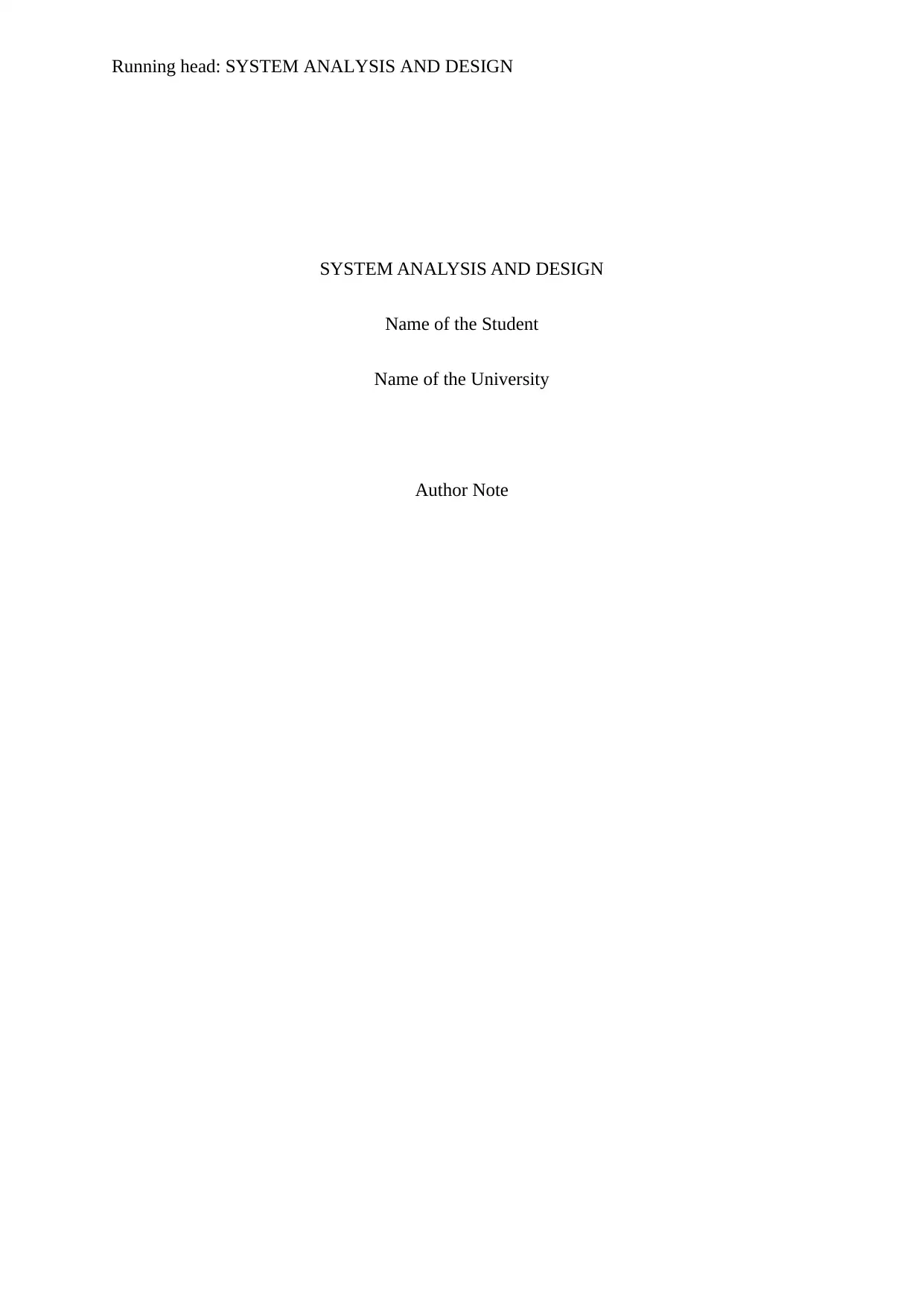
Running head: SYSTEM ANALYSIS AND DESIGN
SYSTEM ANALYSIS AND DESIGN
Name of the Student
Name of the University
Author Note
SYSTEM ANALYSIS AND DESIGN
Name of the Student
Name of the University
Author Note
Paraphrase This Document
Need a fresh take? Get an instant paraphrase of this document with our AI Paraphraser
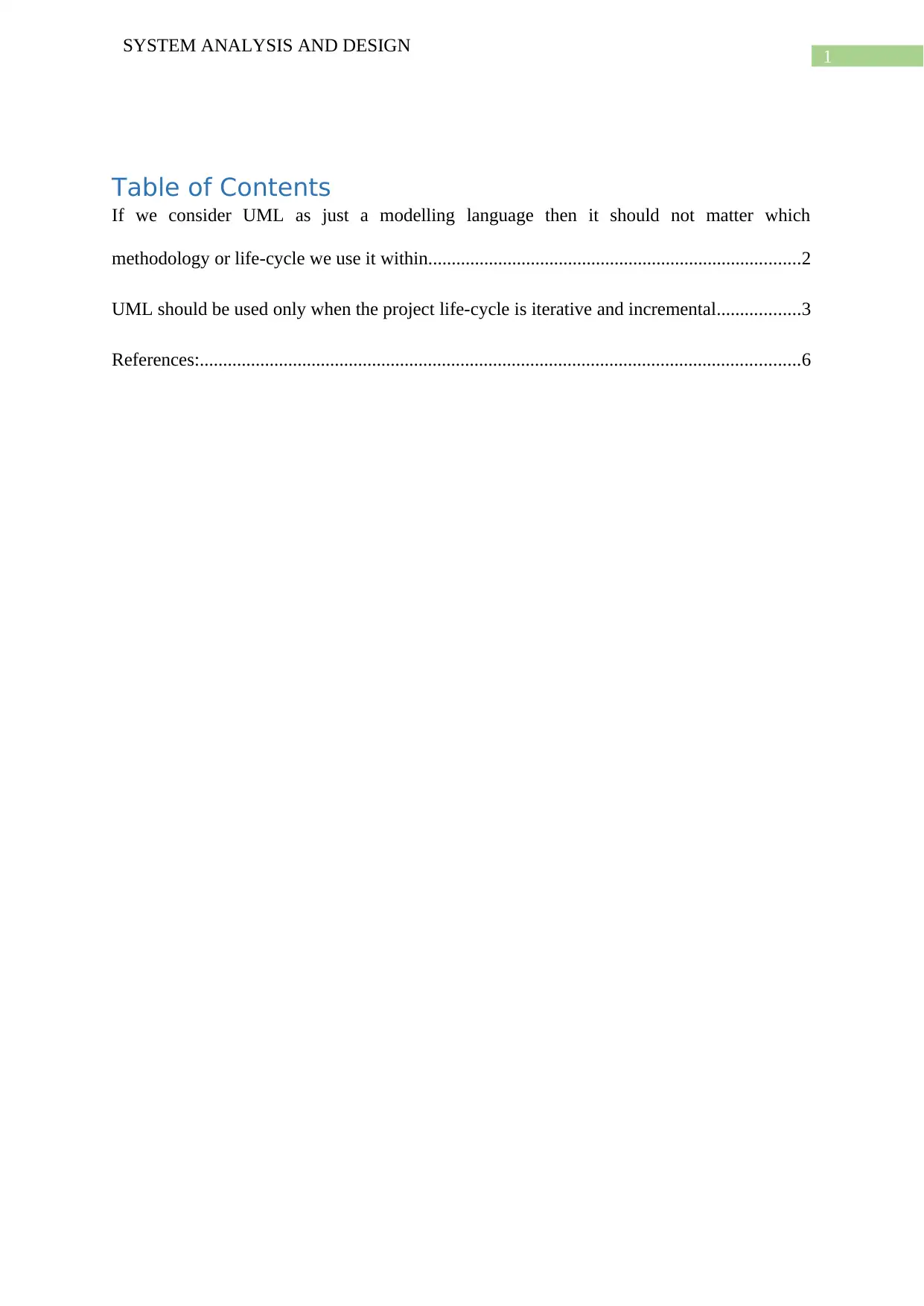
1
SYSTEM ANALYSIS AND DESIGN
Table of Contents
If we consider UML as just a modelling language then it should not matter which
methodology or life-cycle we use it within................................................................................2
UML should be used only when the project life-cycle is iterative and incremental..................3
References:.................................................................................................................................6
SYSTEM ANALYSIS AND DESIGN
Table of Contents
If we consider UML as just a modelling language then it should not matter which
methodology or life-cycle we use it within................................................................................2
UML should be used only when the project life-cycle is iterative and incremental..................3
References:.................................................................................................................................6
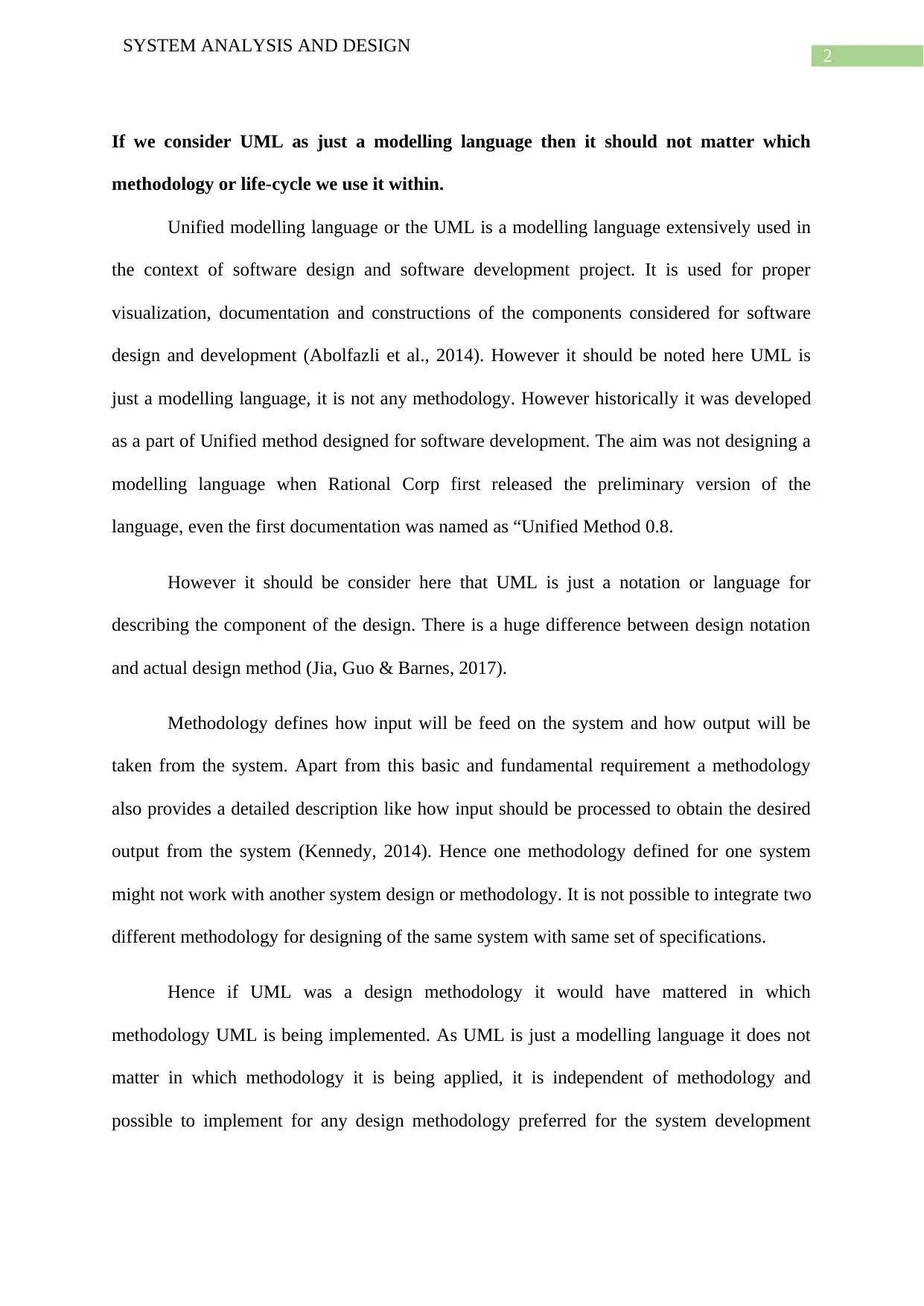
2
SYSTEM ANALYSIS AND DESIGN
If we consider UML as just a modelling language then it should not matter which
methodology or life-cycle we use it within.
Unified modelling language or the UML is a modelling language extensively used in
the context of software design and software development project. It is used for proper
visualization, documentation and constructions of the components considered for software
design and development (Abolfazli et al., 2014). However it should be noted here UML is
just a modelling language, it is not any methodology. However historically it was developed
as a part of Unified method designed for software development. The aim was not designing a
modelling language when Rational Corp first released the preliminary version of the
language, even the first documentation was named as “Unified Method 0.8.
However it should be consider here that UML is just a notation or language for
describing the component of the design. There is a huge difference between design notation
and actual design method (Jia, Guo & Barnes, 2017).
Methodology defines how input will be feed on the system and how output will be
taken from the system. Apart from this basic and fundamental requirement a methodology
also provides a detailed description like how input should be processed to obtain the desired
output from the system (Kennedy, 2014). Hence one methodology defined for one system
might not work with another system design or methodology. It is not possible to integrate two
different methodology for designing of the same system with same set of specifications.
Hence if UML was a design methodology it would have mattered in which
methodology UML is being implemented. As UML is just a modelling language it does not
matter in which methodology it is being applied, it is independent of methodology and
possible to implement for any design methodology preferred for the system development
SYSTEM ANALYSIS AND DESIGN
If we consider UML as just a modelling language then it should not matter which
methodology or life-cycle we use it within.
Unified modelling language or the UML is a modelling language extensively used in
the context of software design and software development project. It is used for proper
visualization, documentation and constructions of the components considered for software
design and development (Abolfazli et al., 2014). However it should be noted here UML is
just a modelling language, it is not any methodology. However historically it was developed
as a part of Unified method designed for software development. The aim was not designing a
modelling language when Rational Corp first released the preliminary version of the
language, even the first documentation was named as “Unified Method 0.8.
However it should be consider here that UML is just a notation or language for
describing the component of the design. There is a huge difference between design notation
and actual design method (Jia, Guo & Barnes, 2017).
Methodology defines how input will be feed on the system and how output will be
taken from the system. Apart from this basic and fundamental requirement a methodology
also provides a detailed description like how input should be processed to obtain the desired
output from the system (Kennedy, 2014). Hence one methodology defined for one system
might not work with another system design or methodology. It is not possible to integrate two
different methodology for designing of the same system with same set of specifications.
Hence if UML was a design methodology it would have mattered in which
methodology UML is being implemented. As UML is just a modelling language it does not
matter in which methodology it is being applied, it is independent of methodology and
possible to implement for any design methodology preferred for the system development
⊘ This is a preview!⊘
Do you want full access?
Subscribe today to unlock all pages.

Trusted by 1+ million students worldwide
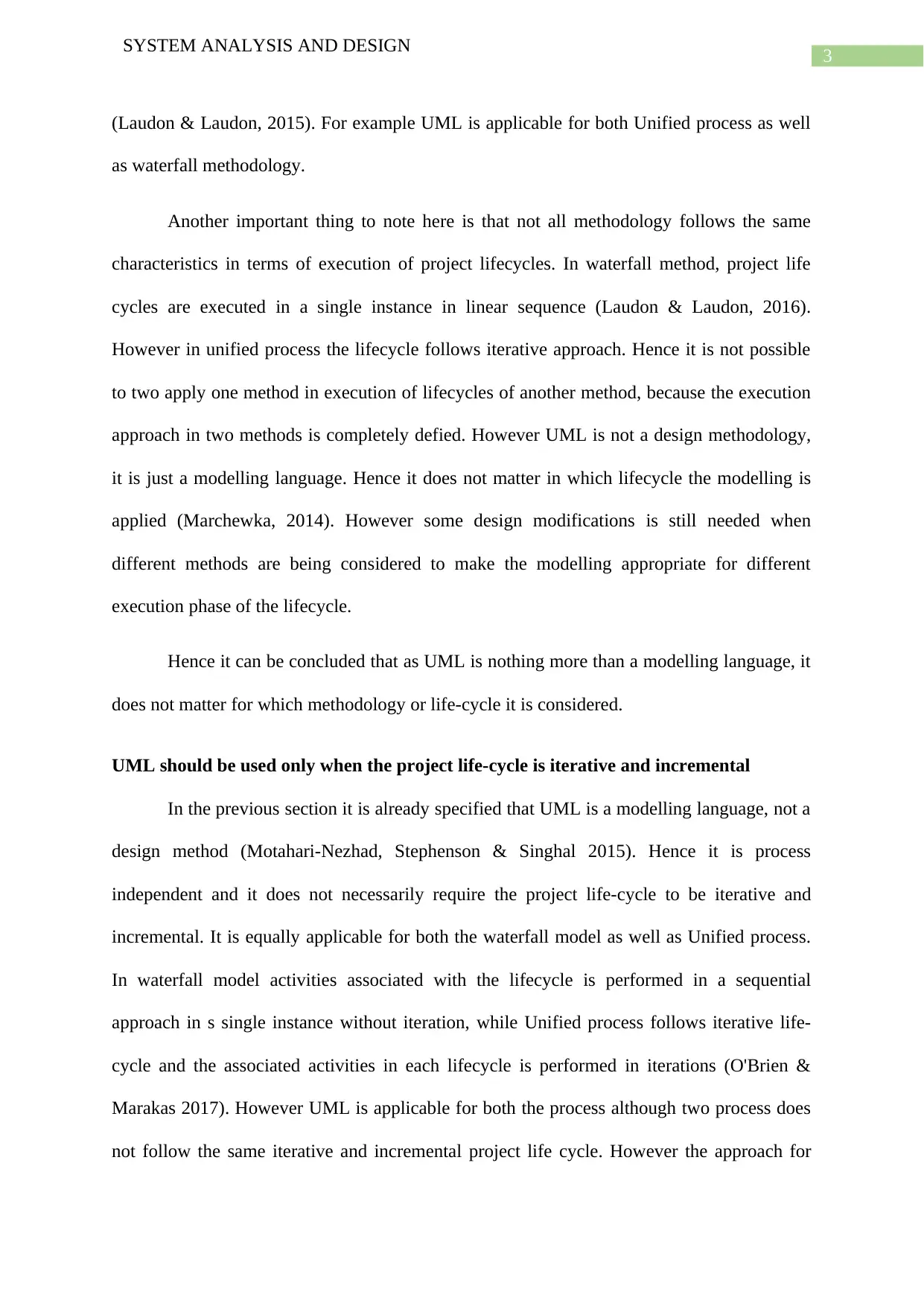
3
SYSTEM ANALYSIS AND DESIGN
(Laudon & Laudon, 2015). For example UML is applicable for both Unified process as well
as waterfall methodology.
Another important thing to note here is that not all methodology follows the same
characteristics in terms of execution of project lifecycles. In waterfall method, project life
cycles are executed in a single instance in linear sequence (Laudon & Laudon, 2016).
However in unified process the lifecycle follows iterative approach. Hence it is not possible
to two apply one method in execution of lifecycles of another method, because the execution
approach in two methods is completely defied. However UML is not a design methodology,
it is just a modelling language. Hence it does not matter in which lifecycle the modelling is
applied (Marchewka, 2014). However some design modifications is still needed when
different methods are being considered to make the modelling appropriate for different
execution phase of the lifecycle.
Hence it can be concluded that as UML is nothing more than a modelling language, it
does not matter for which methodology or life-cycle it is considered.
UML should be used only when the project life-cycle is iterative and incremental
In the previous section it is already specified that UML is a modelling language, not a
design method (Motahari-Nezhad, Stephenson & Singhal 2015). Hence it is process
independent and it does not necessarily require the project life-cycle to be iterative and
incremental. It is equally applicable for both the waterfall model as well as Unified process.
In waterfall model activities associated with the lifecycle is performed in a sequential
approach in s single instance without iteration, while Unified process follows iterative life-
cycle and the associated activities in each lifecycle is performed in iterations (O'Brien &
Marakas 2017). However UML is applicable for both the process although two process does
not follow the same iterative and incremental project life cycle. However the approach for
SYSTEM ANALYSIS AND DESIGN
(Laudon & Laudon, 2015). For example UML is applicable for both Unified process as well
as waterfall methodology.
Another important thing to note here is that not all methodology follows the same
characteristics in terms of execution of project lifecycles. In waterfall method, project life
cycles are executed in a single instance in linear sequence (Laudon & Laudon, 2016).
However in unified process the lifecycle follows iterative approach. Hence it is not possible
to two apply one method in execution of lifecycles of another method, because the execution
approach in two methods is completely defied. However UML is not a design methodology,
it is just a modelling language. Hence it does not matter in which lifecycle the modelling is
applied (Marchewka, 2014). However some design modifications is still needed when
different methods are being considered to make the modelling appropriate for different
execution phase of the lifecycle.
Hence it can be concluded that as UML is nothing more than a modelling language, it
does not matter for which methodology or life-cycle it is considered.
UML should be used only when the project life-cycle is iterative and incremental
In the previous section it is already specified that UML is a modelling language, not a
design method (Motahari-Nezhad, Stephenson & Singhal 2015). Hence it is process
independent and it does not necessarily require the project life-cycle to be iterative and
incremental. It is equally applicable for both the waterfall model as well as Unified process.
In waterfall model activities associated with the lifecycle is performed in a sequential
approach in s single instance without iteration, while Unified process follows iterative life-
cycle and the associated activities in each lifecycle is performed in iterations (O'Brien &
Marakas 2017). However UML is applicable for both the process although two process does
not follow the same iterative and incremental project life cycle. However the approach for
Paraphrase This Document
Need a fresh take? Get an instant paraphrase of this document with our AI Paraphraser
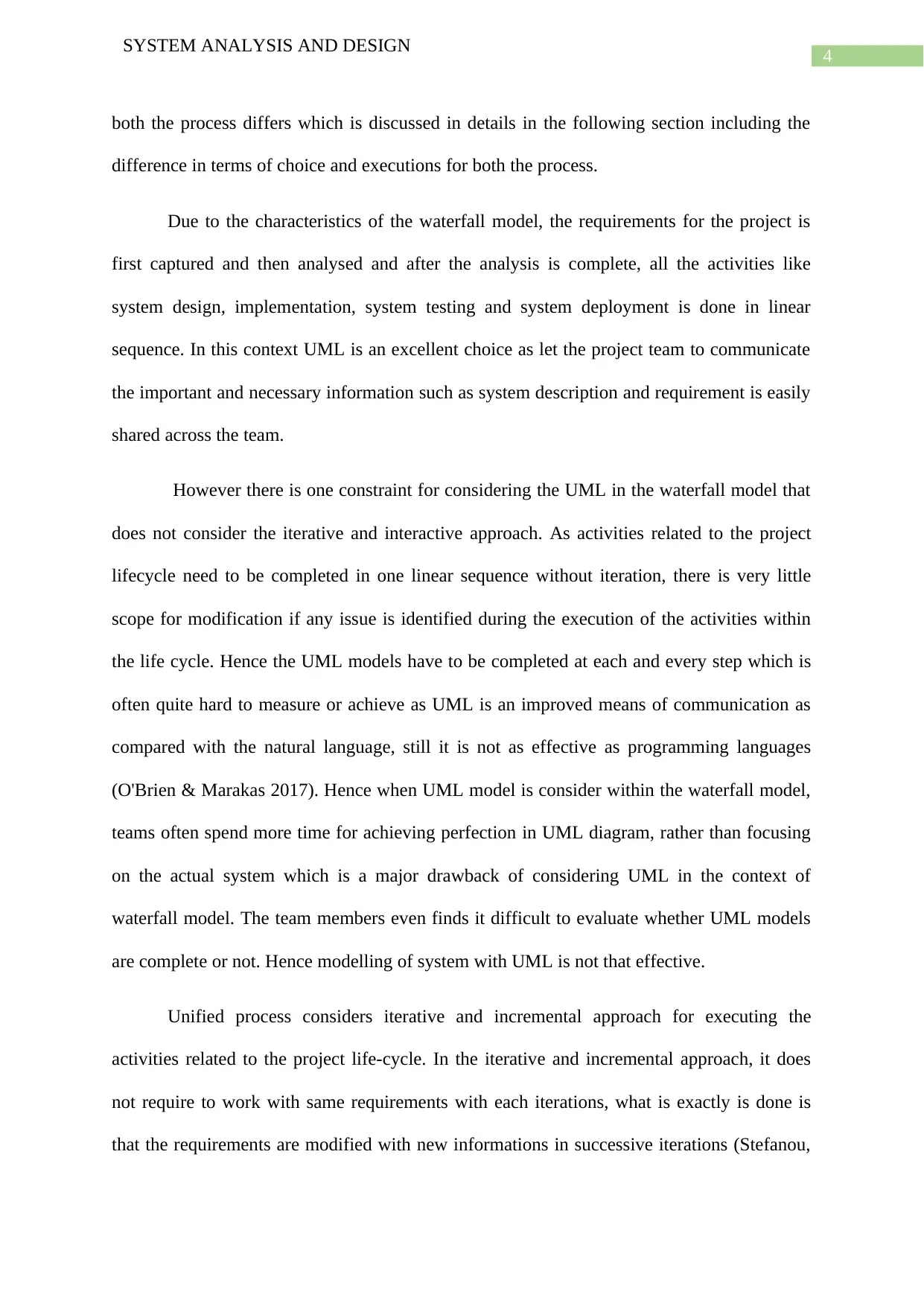
4
SYSTEM ANALYSIS AND DESIGN
both the process differs which is discussed in details in the following section including the
difference in terms of choice and executions for both the process.
Due to the characteristics of the waterfall model, the requirements for the project is
first captured and then analysed and after the analysis is complete, all the activities like
system design, implementation, system testing and system deployment is done in linear
sequence. In this context UML is an excellent choice as let the project team to communicate
the important and necessary information such as system description and requirement is easily
shared across the team.
However there is one constraint for considering the UML in the waterfall model that
does not consider the iterative and interactive approach. As activities related to the project
lifecycle need to be completed in one linear sequence without iteration, there is very little
scope for modification if any issue is identified during the execution of the activities within
the life cycle. Hence the UML models have to be completed at each and every step which is
often quite hard to measure or achieve as UML is an improved means of communication as
compared with the natural language, still it is not as effective as programming languages
(O'Brien & Marakas 2017). Hence when UML model is consider within the waterfall model,
teams often spend more time for achieving perfection in UML diagram, rather than focusing
on the actual system which is a major drawback of considering UML in the context of
waterfall model. The team members even finds it difficult to evaluate whether UML models
are complete or not. Hence modelling of system with UML is not that effective.
Unified process considers iterative and incremental approach for executing the
activities related to the project life-cycle. In the iterative and incremental approach, it does
not require to work with same requirements with each iterations, what is exactly is done is
that the requirements are modified with new informations in successive iterations (Stefanou,
SYSTEM ANALYSIS AND DESIGN
both the process differs which is discussed in details in the following section including the
difference in terms of choice and executions for both the process.
Due to the characteristics of the waterfall model, the requirements for the project is
first captured and then analysed and after the analysis is complete, all the activities like
system design, implementation, system testing and system deployment is done in linear
sequence. In this context UML is an excellent choice as let the project team to communicate
the important and necessary information such as system description and requirement is easily
shared across the team.
However there is one constraint for considering the UML in the waterfall model that
does not consider the iterative and interactive approach. As activities related to the project
lifecycle need to be completed in one linear sequence without iteration, there is very little
scope for modification if any issue is identified during the execution of the activities within
the life cycle. Hence the UML models have to be completed at each and every step which is
often quite hard to measure or achieve as UML is an improved means of communication as
compared with the natural language, still it is not as effective as programming languages
(O'Brien & Marakas 2017). Hence when UML model is consider within the waterfall model,
teams often spend more time for achieving perfection in UML diagram, rather than focusing
on the actual system which is a major drawback of considering UML in the context of
waterfall model. The team members even finds it difficult to evaluate whether UML models
are complete or not. Hence modelling of system with UML is not that effective.
Unified process considers iterative and incremental approach for executing the
activities related to the project life-cycle. In the iterative and incremental approach, it does
not require to work with same requirements with each iterations, what is exactly is done is
that the requirements are modified with new informations in successive iterations (Stefanou,
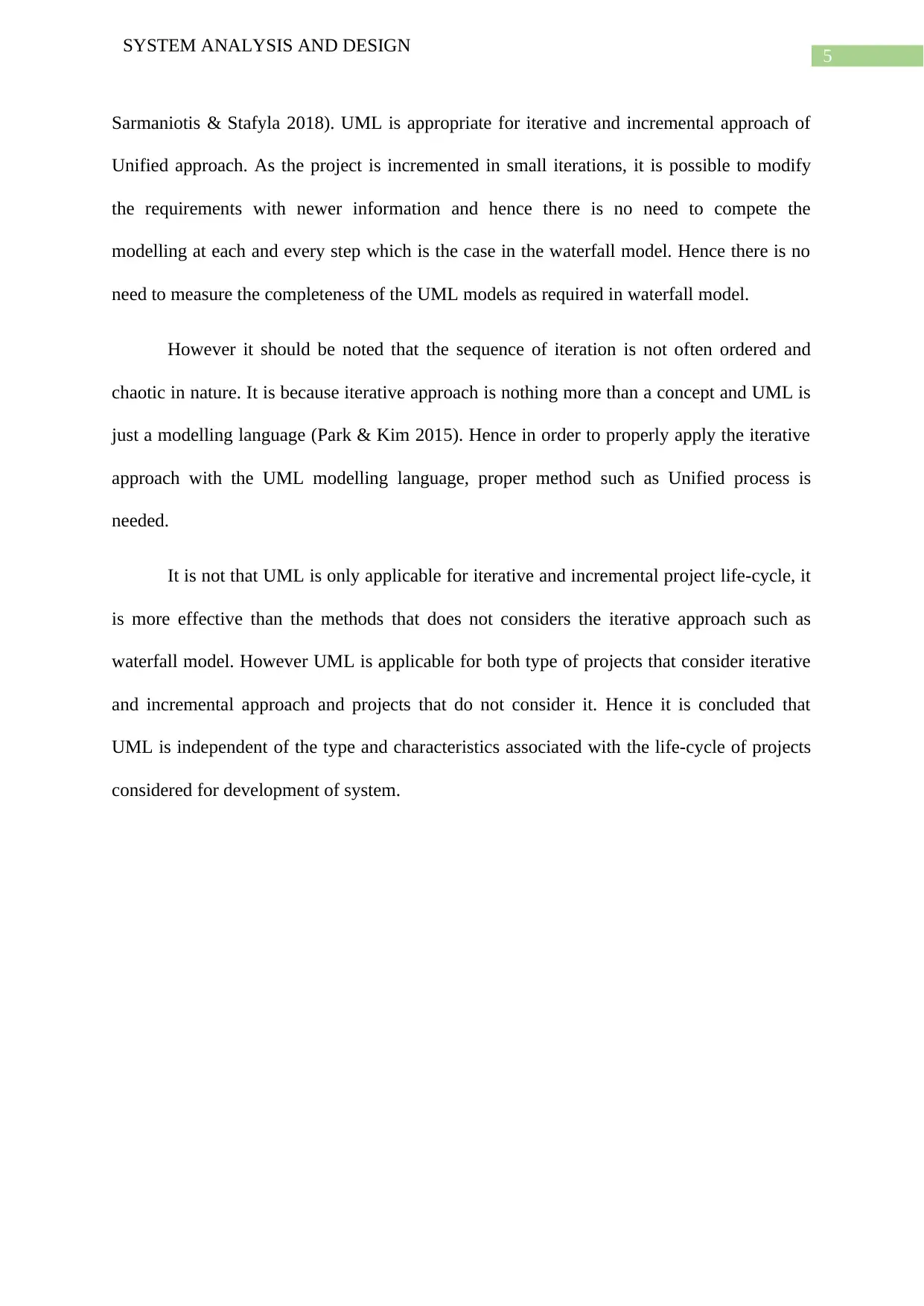
5
SYSTEM ANALYSIS AND DESIGN
Sarmaniotis & Stafyla 2018). UML is appropriate for iterative and incremental approach of
Unified approach. As the project is incremented in small iterations, it is possible to modify
the requirements with newer information and hence there is no need to compete the
modelling at each and every step which is the case in the waterfall model. Hence there is no
need to measure the completeness of the UML models as required in waterfall model.
However it should be noted that the sequence of iteration is not often ordered and
chaotic in nature. It is because iterative approach is nothing more than a concept and UML is
just a modelling language (Park & Kim 2015). Hence in order to properly apply the iterative
approach with the UML modelling language, proper method such as Unified process is
needed.
It is not that UML is only applicable for iterative and incremental project life-cycle, it
is more effective than the methods that does not considers the iterative approach such as
waterfall model. However UML is applicable for both type of projects that consider iterative
and incremental approach and projects that do not consider it. Hence it is concluded that
UML is independent of the type and characteristics associated with the life-cycle of projects
considered for development of system.
SYSTEM ANALYSIS AND DESIGN
Sarmaniotis & Stafyla 2018). UML is appropriate for iterative and incremental approach of
Unified approach. As the project is incremented in small iterations, it is possible to modify
the requirements with newer information and hence there is no need to compete the
modelling at each and every step which is the case in the waterfall model. Hence there is no
need to measure the completeness of the UML models as required in waterfall model.
However it should be noted that the sequence of iteration is not often ordered and
chaotic in nature. It is because iterative approach is nothing more than a concept and UML is
just a modelling language (Park & Kim 2015). Hence in order to properly apply the iterative
approach with the UML modelling language, proper method such as Unified process is
needed.
It is not that UML is only applicable for iterative and incremental project life-cycle, it
is more effective than the methods that does not considers the iterative approach such as
waterfall model. However UML is applicable for both type of projects that consider iterative
and incremental approach and projects that do not consider it. Hence it is concluded that
UML is independent of the type and characteristics associated with the life-cycle of projects
considered for development of system.
⊘ This is a preview!⊘
Do you want full access?
Subscribe today to unlock all pages.

Trusted by 1+ million students worldwide
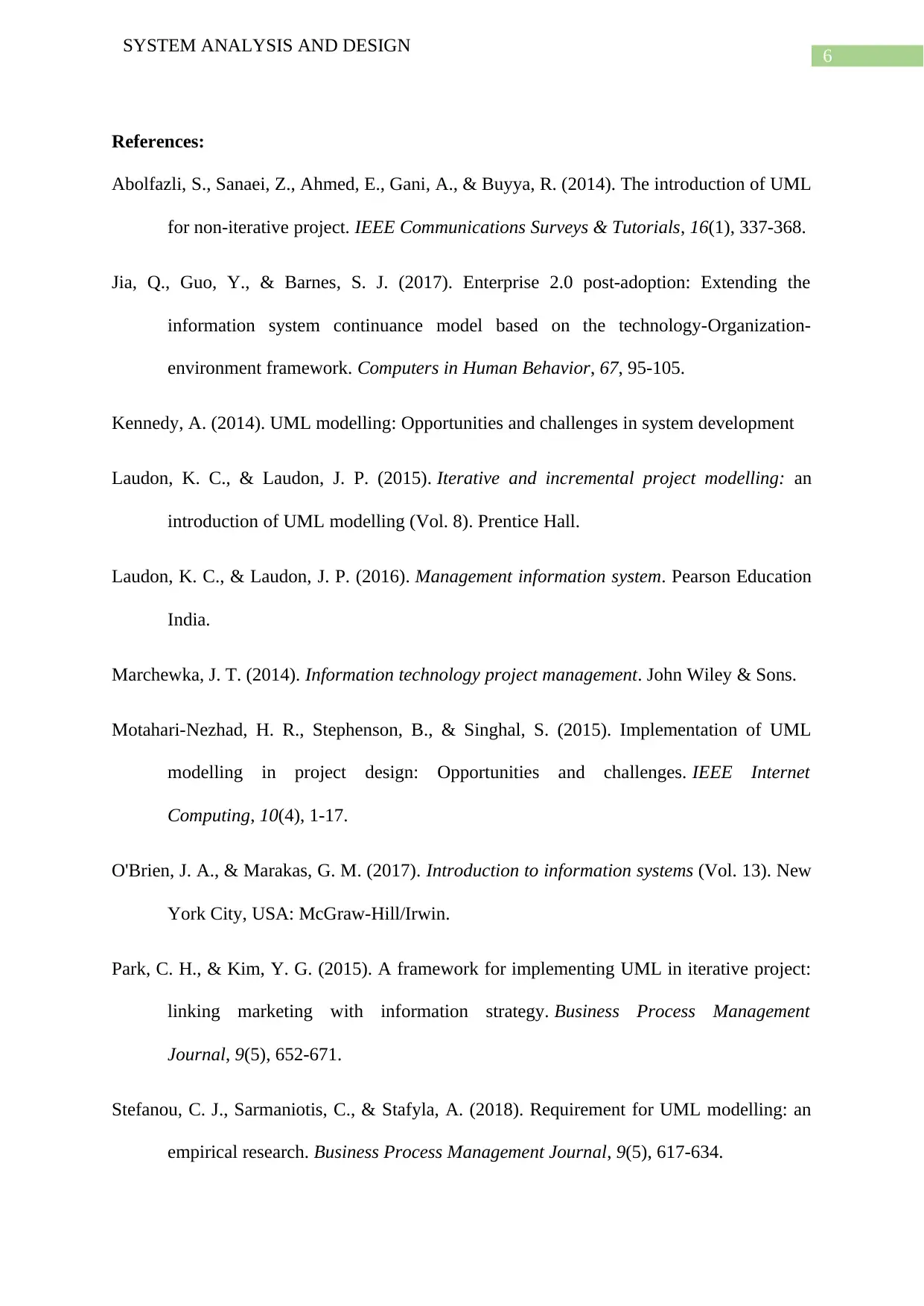
6
SYSTEM ANALYSIS AND DESIGN
References:
Abolfazli, S., Sanaei, Z., Ahmed, E., Gani, A., & Buyya, R. (2014). The introduction of UML
for non-iterative project. IEEE Communications Surveys & Tutorials, 16(1), 337-368.
Jia, Q., Guo, Y., & Barnes, S. J. (2017). Enterprise 2.0 post-adoption: Extending the
information system continuance model based on the technology-Organization-
environment framework. Computers in Human Behavior, 67, 95-105.
Kennedy, A. (2014). UML modelling: Opportunities and challenges in system development
Laudon, K. C., & Laudon, J. P. (2015). Iterative and incremental project modelling: an
introduction of UML modelling (Vol. 8). Prentice Hall.
Laudon, K. C., & Laudon, J. P. (2016). Management information system. Pearson Education
India.
Marchewka, J. T. (2014). Information technology project management. John Wiley & Sons.
Motahari-Nezhad, H. R., Stephenson, B., & Singhal, S. (2015). Implementation of UML
modelling in project design: Opportunities and challenges. IEEE Internet
Computing, 10(4), 1-17.
O'Brien, J. A., & Marakas, G. M. (2017). Introduction to information systems (Vol. 13). New
York City, USA: McGraw-Hill/Irwin.
Park, C. H., & Kim, Y. G. (2015). A framework for implementing UML in iterative project:
linking marketing with information strategy. Business Process Management
Journal, 9(5), 652-671.
Stefanou, C. J., Sarmaniotis, C., & Stafyla, A. (2018). Requirement for UML modelling: an
empirical research. Business Process Management Journal, 9(5), 617-634.
SYSTEM ANALYSIS AND DESIGN
References:
Abolfazli, S., Sanaei, Z., Ahmed, E., Gani, A., & Buyya, R. (2014). The introduction of UML
for non-iterative project. IEEE Communications Surveys & Tutorials, 16(1), 337-368.
Jia, Q., Guo, Y., & Barnes, S. J. (2017). Enterprise 2.0 post-adoption: Extending the
information system continuance model based on the technology-Organization-
environment framework. Computers in Human Behavior, 67, 95-105.
Kennedy, A. (2014). UML modelling: Opportunities and challenges in system development
Laudon, K. C., & Laudon, J. P. (2015). Iterative and incremental project modelling: an
introduction of UML modelling (Vol. 8). Prentice Hall.
Laudon, K. C., & Laudon, J. P. (2016). Management information system. Pearson Education
India.
Marchewka, J. T. (2014). Information technology project management. John Wiley & Sons.
Motahari-Nezhad, H. R., Stephenson, B., & Singhal, S. (2015). Implementation of UML
modelling in project design: Opportunities and challenges. IEEE Internet
Computing, 10(4), 1-17.
O'Brien, J. A., & Marakas, G. M. (2017). Introduction to information systems (Vol. 13). New
York City, USA: McGraw-Hill/Irwin.
Park, C. H., & Kim, Y. G. (2015). A framework for implementing UML in iterative project:
linking marketing with information strategy. Business Process Management
Journal, 9(5), 652-671.
Stefanou, C. J., Sarmaniotis, C., & Stafyla, A. (2018). Requirement for UML modelling: an
empirical research. Business Process Management Journal, 9(5), 617-634.
1 out of 7
Related Documents
Your All-in-One AI-Powered Toolkit for Academic Success.
+13062052269
info@desklib.com
Available 24*7 on WhatsApp / Email
![[object Object]](/_next/static/media/star-bottom.7253800d.svg)
Unlock your academic potential
Copyright © 2020–2025 A2Z Services. All Rights Reserved. Developed and managed by ZUCOL.





